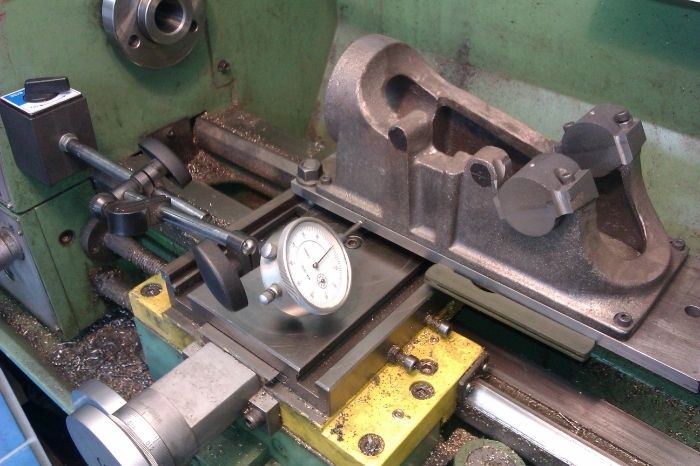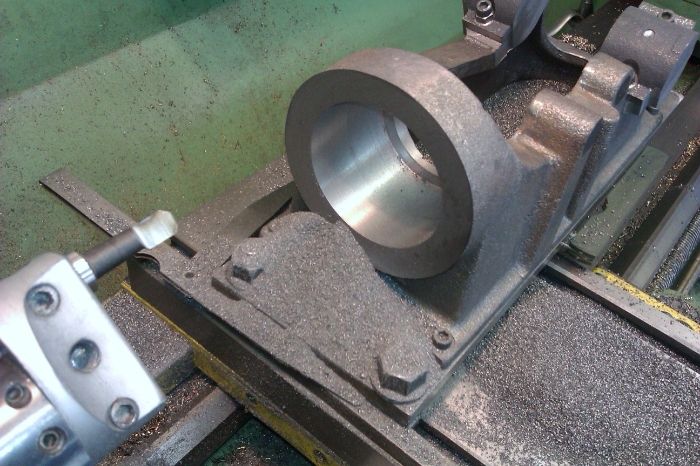fly cutter ptoblems
| Philip Burley | 05/03/2018 18:15:12 |
198 forum posts 1 photos | I am trying to machine a cast iron valve face with a fly cutter . but it blunts very quickly , Iron files easily . Cutter is turning about 250 rpm , 1 1/2 radius . what am I doing wrong |
| JasonB | 05/03/2018 18:23:29 |
25215 forum posts 3105 photos 1 articles | Bit fast swinging a 3" diameter, should be about 85rpm with HSS cutter in iron but you may need to run a bit faster if the mill lacks power at low speed |
| Zan | 05/03/2018 18:45:53 |
| 356 forum posts 25 photos | Yes too fast I run my 32mm dai at 200 with no problems and long tool life so reduce speed or diameter of cut |
| Hillclimber | 06/03/2018 07:58:27 |
215 forum posts 51 photos | I recently found I could use a small left-hand CCMT carbide insert tool in my morse-taper flycutter. Might help with cast iron? |
| Philip Burley | 06/03/2018 09:31:02 |
198 forum posts 1 photos | I wondered about a carbide cutter , but would it stand up to an interrupted cut . Regrinding my HHS this morning and trying much lower speed |
| Vic | 06/03/2018 09:33:45 |
| 3453 forum posts 23 photos | I use a 12mm round carbide insert in my fly cutter and it works fine. |
| Dusty | 06/03/2018 09:35:00 |
| 498 forum posts 9 photos | You may find that a carbide tool chips, as they generally do not like interrupted cuts, a fly cutter reproduces that to quite an extreme degree. |
| Muzzer | 06/03/2018 09:52:28 |
2904 forum posts 448 photos | That's a bit of a lazy cliche. There are many carbide inserts that are designed for interrupted cuts - for one thing, consider milling cutters that by definition spend their life doing interrupted cuts. For turning, there are both geometries and materials that are optimised for that application. Obviously you wouldn't expect to see a ground edge (finishing tool) used to rough out a casting. For that you tend to find the edges are less sharp and more robust. Choosing an insert that is described as suitable for roughing milling of CI might be a start.... Murray Edited By Muzzer on 06/03/2018 09:58:12 |
| Hillclimber | 06/03/2018 09:55:06 |
215 forum posts 51 photos | I was dressing EN3, but it worked fine. CCMT inserts are small and well-supported, and this may help. Also depends on the form of the flycutter. I was using a 2MT flycutter from Arc, with one of their 8mm holders. |
| Dusty | 06/03/2018 10:22:48 |
| 498 forum posts 9 photos | Hi Murray I agree, if you are going to research the most suitable insert of course it will work, but I suspect most hobby engineers will not have a suitable insert to hand but will use an insert designed for turning round stock, as most of those supplied to us are designed for. My point was, if you use a standard carbide insert do not be surprised if it chips. |
| Hopper | 06/03/2018 11:21:15 |
7881 forum posts 397 photos | The traditional formula for calculating RPM of either the job in the lathe or the outer edge of a milling cutter is RPM = 4 x Cs/D where Cs is the cutting speed in feet per minute. 100 for mild steel. 60 for cast iron. 200 for brass and ally. D is the diameter of the job, or the milling cutter OD, in inches. So you get 4 x 60 divided by 3, which gives as near as dammit to Jason's 85rpm. Just so you know how to work it out for future jobs. The shortcut way is to divide 400 by the diameter in inches. Then for cast iron, halve the answer. For brass or ally, double it. Edited By Hopper on 06/03/2018 11:22:30 |
| JasonB | 06/03/2018 13:16:04 |
25215 forum posts 3105 photos 1 articles | I don't flycut CI often buy when I do a CCMT insert same as I use for turning works fine, I doubt any of you change inserts when turning square stock of an odd shaped item in the 4-jaw so no problem with interupted cuts. You can also run carbide quite a bit faster |
| Hillclimber | 06/03/2018 13:36:48 |
215 forum posts 51 photos | Jason, slight change of subject. But can you explain the cutting direction you are using here? It appears be towards the operator. On my Myford I would have (maybe wrongly) passed the cross slide away from the operator so that loads are carried towards the bed? But my money is on you having rather more experience.... Cheers, Colin |
| JasonB | 06/03/2018 16:27:58 |
25215 forum posts 3105 photos 1 articles | I think it was a case of having to mount it that way round as I did not have the room to swing the flycutter clear of the work if it was mounted towards the front of the cross slide. Also with it in that position I had the most slide engaged in the dovetails. The hole for end of the cylinder liner was also bored out at that setting.
|
Please login to post a reply.
Want the latest issue of Model Engineer or Model Engineers' Workshop? Use our magazine locator links to find your nearest stockist!
Sign up to our newsletter and get a free digital issue.
You can unsubscribe at anytime. View our privacy policy at www.mortons.co.uk/privacy
- hemingway ball turner
04/07/2025 14:40:26 - *Oct 2023: FORUM MIGRATION TIMELINE*
05/10/2023 07:57:11 - Making ER11 collet chuck
05/10/2023 07:56:24 - What did you do today? 2023
05/10/2023 07:25:01 - Orrery
05/10/2023 06:00:41 - Wera hand-tools
05/10/2023 05:47:07 - New member
05/10/2023 04:40:11 - Problems with external pot on at1 vfd
05/10/2023 00:06:32 - Drain plug
04/10/2023 23:36:17 - digi phase converter for 10 machines.....
04/10/2023 23:13:48 - More Latest Posts...
- View All Topics
- Reeves** - Rebuilt Royal Scot by Martin Evans
by John Broughton
£300.00 - BRITANNIA 5" GAUGE James Perrier
by Jon Seabright 1
£2,500.00 - Drill Grinder - for restoration
by Nigel Graham 2
£0.00 - WARCO WM18 MILLING MACHINE
by Alex Chudley
£1,200.00 - MYFORD SUPER 7 LATHE
by Alex Chudley
£2,000.00 - More "For Sale" Ads...
- D1-3 backplate
by Michael Horley
Price Not Specified - fixed steady for a Colchester bantam mark1 800
by George Jervis
Price Not Specified - lbsc pansy
by JACK SIDEBOTHAM
Price Not Specified - Pratt Burnerd multifit chuck key.
by Tim Riome
Price Not Specified - BANDSAW BLADE WELDER
by HUGH
Price Not Specified - More "Wanted" Ads...
Do you want to contact the Model Engineer and Model Engineers' Workshop team?
You can contact us by phone, mail or email about the magazines including becoming a contributor, submitting reader's letters or making queries about articles. You can also get in touch about this website, advertising or other general issues.
Click THIS LINK for full contact details.
For subscription issues please see THIS LINK.
Model Engineer Magazine
- Percival Marshall
- M.E. History
- LittleLEC
- M.E. Clock
ME Workshop
- An Adcock
- & Shipley
- Horizontal
- Mill
Subscribe Now
- Great savings
- Delivered to your door
Pre-order your copy!
- Delivered to your doorstep!
- Free UK delivery!












 Register
Register Log-in
Log-in


